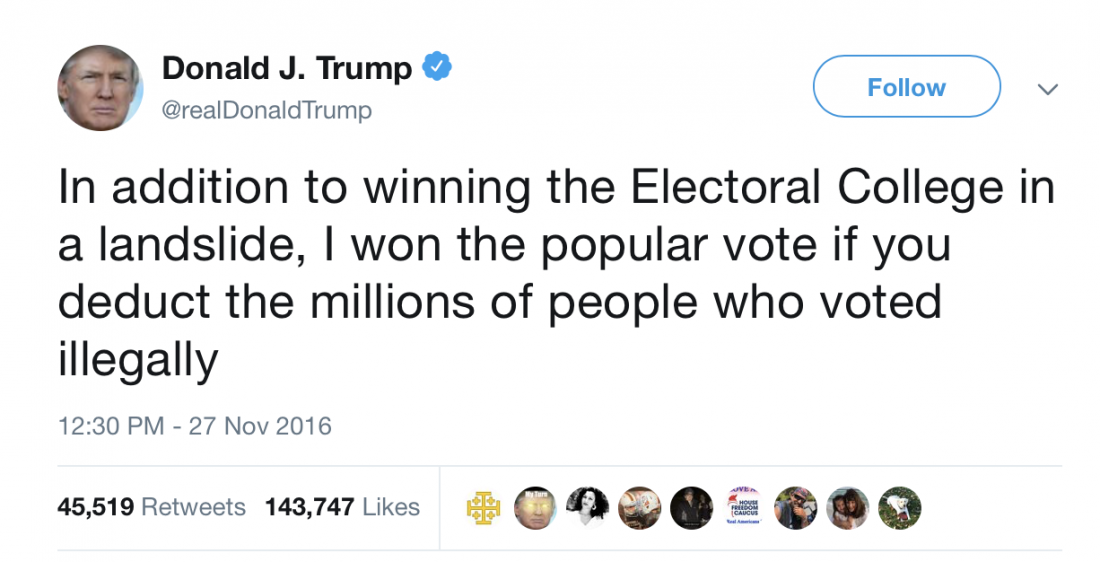By Flora Georgianna.
During the 2016 Presidential election campaign, Donald Trump insisted that “large scale voter fraud” was harming his chances for victory. After winning the White House, unable to let the idea go, Trump claimed that the votes of thousands of undocumented immigrants and non-citizens caused him dramatic losses in Democratic states such as California. His false accusations soon echoed through the bubble of conservative media and resurfaced during the next election cycle. In 2018, for example, Fox Business commentator Lou Dobbs claimed that millions of undocumented immigrants voted in the midterm elections, causing Democrats to take back control of the House of Representatives.
This was, of course, soon proven wrong. PolitiFact reported that there were just 50 instances of alleged noncitizen voting between 2000 and 2011. A different, more comprehensive investigation found there to be only 31 credible instances of voter fraud by impersonation between 2000 and 2014, out of a billion votes total, proving that Trump’s claims of voter fraud are fabricated. Trump has used this partisan rhetoric of voter fraud to push legislation for stronger voter security measures (such as voter ID laws and exact-match policies) which are shown to target marginalized people to advance Republican political gain. For a man as powerful as the president of the country to support such practices of voter suppression undermines the power of the people in a modern capitalist democracy, and destroys voters’ trust in their political system.
The most important victory in voting rights came in 1965, when President Lyndon Johnson signed the Voting Rights Act into law, allowing marginalized peoples their full right to vote as outlined in the 15th Amendment. Section 5 prevented districts from altering voting policies in a way that would “negatively impact any individual’s right to vote based on race or minority status.” Section 4(b) attempted to address these issues specifically in districts with low voter turnout and voting tests still in place before the ratification of the VRA. In 2013, Shelby County v. Holder was presented to the Supreme Court. The Alabama county wanted to declare Sections 4(b) and 5 unconstitutional, claiming they violated the Tenth Amendment, that the federal government could not extend its power into the jurisdiction of the states. This would essentially strip back voting rights and add an extra layer of security to the voting process. Shelby County lost in the district court, then in the appellate court, until the Supreme Court ruled in their favor, claiming that Section 4(b) was unconstitutional since the voter suppression of the 1960s was “no longer evident.”
Conservative Alabaman politicians saw this as a victory, as these unjust voting policies were meant to target the coalition of African American, Asian, Latine, young, and poor voters that President Obama was able to rally during his 2008 campaign. This left-wing base posed a direct threat to conservatives. In swing states such as Michigan, which Trump won by only 10,700 votes, Republicans knew well that imposing stronger voter security measures would fracture the Obama coalition, removing the voting power of thousands of marginalized people, and justified it by (falsely) claiming that voter fraud would corrupt election results otherwise. Democratic Senator Cory Booker challenged Trump on his voter suppression policies: Booker cited Michigan’s obsolete voting policies before the 2016 election as partisan and corrupt. The policies in question were spearheaded by the Republican party, barred citizens from automatically enrolling to vote while at the DMV, and required a reason for absentee voting. The government rolled back these policies soon after the 2016 election, but as ACLU strategist Sharon Dolente asserts, the current voter policy “would have significantly increased turnout… in 2016. I don’t know how [those kept from voting in 2016] would have voted but it would have been more than 11,000 voters,” or enough to make an impact in the general election. The Republicans advocating for these security measures knew clear as day the effect that they would have on election results, swinging the vote enough in their favor to win Michigan and several other swing states.
New media has made it exponentially easier to spread misinformation about voter suppression because of its speed and the lack of accountability to the truth. Consider Trump’s use of Twitter to announce major policy, staff turnover, and sensitive White House matters usually reserved to press briefings. The social network allows him to defend his prejudiced policies, attack his critics, thank his GOP colleagues, and instantly reach his 66 million followers. Trump is no stranger to making false or misleading claims, but his use of Twitter only increases their frequency to the point where even the biggest fact-checking services have to choose what to disprove. This lack of accountability, combined with Trump’s impressive Twitter following allows him to ultimately say anything and be believed by millions. A tweet wherein he claims millions voted illegally can reach 100,000 likes and tens of thousands of retweets. That’s over 100,000 people who saw, believed, and spread that tweet, all in less than a minute. And when Trump claims that increased voter security can fix this, that is another 100,000 people who listen and believe him. The consequences of his Twitter use have only begun to show.
Why is Trump specifically so adamant about increased voter security? He masks his self-serving policy in the idea that voter ID laws and other measures are “necessary” to protect the integrity of elections. Trump and his far-right allies are cognizant that voter suppression benefits their party and that fake news can be used as a tool in bolstering their thinly-masked white supremacist ideology. When Trump claims “voter fraud,” he uses widespread paranoia to mask his and his party’s rampant attempts to undermine the voting power of the American people.
